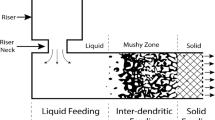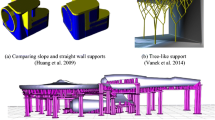Abstract
To solve the problem of the uneven thickness distribution of a formed part caused by a large difference between the forming angles and the different curvatures of the surfaces in CNC incremental forming, a combinatorial optimization method of multidirectional sheet postures was proposed based on particle swarm optimization. In this method, an infinite number of optional sheet postures at each point in the forming area are taken as the combined object. The optimization goal is to make the forming angles of the entire sheet part be smaller than the forming limit angle and to minimize the difference between them; then find the optimal combination of the multidirectional sheet postures that can be selected at each point in the forming area. Case studies of the algorithm and the actual forming experiment show that not only can the optimized multidirectional sheet metal postures determined by the proposed method realize the non-fracture forming of the sheet metal parts with different forming angles and different curvature of the surface, but also obtain a more uniform thickness distribution of the formed parts.
Similar content being viewed by others
Abbreviations
- Oij :
-
The central point of the radial line
- θ ij :
-
The angle of inclination of the radial line
- θ lim :
-
Forming limit angle
- α initial :
-
The initial forming angle of the easily-forming surface
- β initial :
-
The initial forming angle of the difficult-forming surface
- α ij :
-
The forming angle on the easy-forming surface
- β ij :
-
The forming angle on the difficult-forming surface
- m :
-
The normal vector of the horizontal plane
- i :
-
The particle in the population
- d :
-
The space dimension
- t :
-
The iteration times of the algorithm
- C1, C2 :
-
The acceleration constants of the particles
- r1, r2 :
-
The random numbers uniformly distributed between [0, 1]
References
H. Wang, Y. B. Gu, X. Z. Guo, H. T. Wang, J. Tao and Y. Xu, Microstructure and mechanical properties of 2060-T8 Al-Li alloy after warm incremental forming, Journal of Mechanical Science and Technology, 32(10) (2018) 4801–4812.
S. Torsakul and N. Kuptasthien, Effects of three parameters on forming force of the single point incremental forming process, Journal of Mechanical Science and Technology, 33(6) (2019) 2817–2823.
Y. L. Li, X. X. Chen, Z. B. Liu, J. Sun, F. Li, J. F. Li and G. Q. Zhao, A review on the recent development of incremental sheet-forming process, Int. J. Adv. Manuf. Technol., 92(5–8) (2017) 2439–2462.
J. R. Duflou, A. M. Habraken, J. Cao, R. Malhotra, M. Bambach, D. Adams, H. Vanhove, A. Mohammadi and J. Jeswiet, Single point incremental forming: state-of-the-art and prospects, Int. J. Mater Form, 11(6) (2018) 743–773.
A. K. Behera, R. A. de Sousa, G. Ingarao and V. Oleksik, Single point incremental forming: An assessment of the progress and technology trends from 2005 to 2015, J. of Manuf Process, 27 (2017) 37–62.
G. Ambrogio, L. Filice, M. Gaudioso and G. L. Manco, Optimized tool-path design to reduce thinning in ISF process, Int. J. Mater Form, 3(1) (2010) 959–962.
H. Zhang, B. Lu, J. Chen, S. L. Feng, Z. Q. Li and H. Long, Thickness control in a new flexible hybrid incremental sheet forming process, Proc. Inst. Mech. Eng., Part B, 231(5) (2017) 779–791.
S. Parnika, K. Pavan, T. Puneet and P. Alexander, Improvement in formability and geometrical accuracy of incrementally formed AA1050 sheets by microstructure and texture reformation through preheating, and their FEA and experimental validation, J. Braz Soc. of Mech. Sci. Eng., 40(7) (2018) 335–349.
H. Choi and C. Lee, A mathematical model to predict thickness distribution and formability of incremental forming combined with stretch forming, Rob Comput-Integr Manuf., 55(Part B) (2019) 164–172.
D. Maheshwar and K. Vinayak, The effect of process parameters on forming forces in single point incremental forming, Procedia Manuf., 29 (2019) 120–128.
M. Sathish and K. C. Udaiyakumar, Experimental investigation and analytical model for improving the thickness distribution in multi-point incremental forming in sheet metal, Mater Today: Proc., 5(2) (2018) 12045–12055.
H. Zhu, J. Ju and J. L. Bai, Research on the forming direction optimization for the uniformity of the sheet part thickness in the CNC incremental forming, Int. J. Adv. Manuf. Technol., 93(5–8) (2017) 2547–2559.
H. Vanhove, J. Gu, H. Sol and J. R. Duflou, Process window extension for incremental forming through optimal work plane rotation, Spec Ed: 10th Int Conf Technol Plast (2011) 508–512.
S. Tanaka, K. Hayakawa and T. Nakamura, Incremental sheet forming with direction control of path planes, Spec Ed: 10th Int Conf Technol Plast (2011) 503–507.
H. Zhu, J. Ju and J. L. Bai, Sheet thickness homogenization in CNC incremental forming based on tilted forming path, Comput. Integr. Manuf. Syst., 24(3) (2018) 631–638.
H. Zhu and H. Y. Li, 5-Axis CNC incremental forming toolpath generation based on formability, Int. J. Adv. Manuf. Technol., 94(1–4) (2018) 1061–1072.
J. L. Li, Research on CNC Incremental Forming based on Multi-direction Real-time Adjustment of Sheet Posture, Shenyang: Shenyang Aerospace University (2019).
Y. M. Liu and B. Niu, The Theory and Practice of New Particle Swarm Optimization, Beijing: Science Press (2013).
Z. Ji, H. L. Liao and Q. H. Wu, Particle Swarm Optimization and Its Application, Beijing: Science Press (2010).
Q. K. Zhang, Research on the Particle Swarm Optimization and Differential Evolution Algorithms, Shandong: Shandong University (2017).
J. W. Zhuo, Y. S. Wei, J. Qin and B. W. Li, Application of MATLAB in Mathematical Modeling, Beijing: Beihang University Press (2011).
Author information
Authors and Affiliations
Corresponding author
Additional information
Conflict of interest
The authors declare that they have no conflict of interest.
Hu Zhu is a Professor in the College of Mechanical and Electrical Engineering at Shenyang Aerospace University. He received his B.S. from Jilin University, and M.S. and Ph.D. in the Department of Mechanical Design and Production Engineering at Seoul National University. His current research interests include CAD/CAM, 3D printing, CNC incremental forming.
Yang Wang is currently an M.S. student in the College of Mechanical and Electrical Engineering at Shenyang Aerospace University. He received his B.S. from the Mechanical Manufacturing and Automation at Shenyang Aerospace University. His research interests include CAD/CAM, CNC incremental forming.
Jaeguan Kang is currently a Professor of Mechanical Engineering at the Kyungnam University. He received his Ph.D. from Pohang University of Science and Technology, M.S. from Korea Advanced Institute of Science and Technology, B.S. from Seoul National University. His primary research interests include CAD/CAM, Incremental sheet metal forming.
Rights and permissions
About this article
Cite this article
Zhu, H., Wang, Y. & Kang, J. Research on combinatorial optimization of multidirectional sheet postures for forming thickness uniformity. J Mech Sci Technol 34, 4251–4261 (2020). https://doi.org/10.1007/s12206-020-0917-6
Received:
Revised:
Accepted:
Published:
Issue Date:
DOI: https://doi.org/10.1007/s12206-020-0917-6




